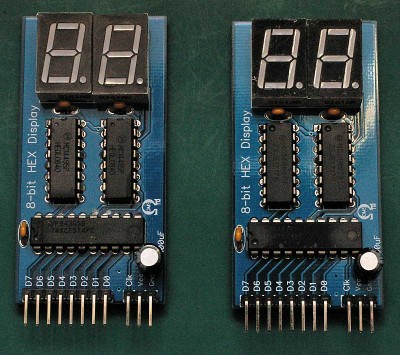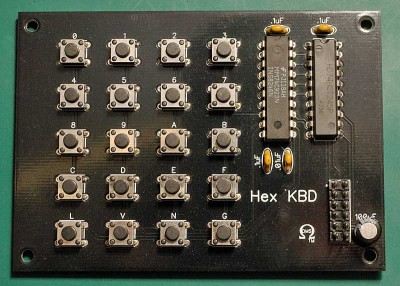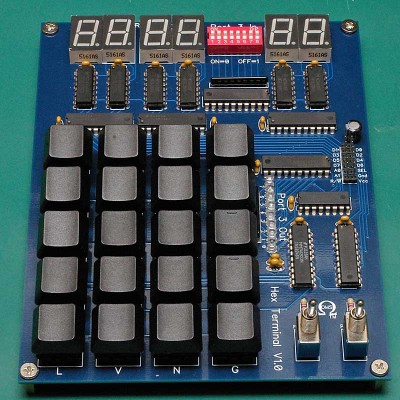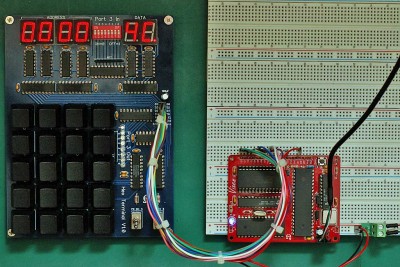A couple of months back I wanted to create some little hex displays that plugged into a breadboard to use as monitors for data/address/etc. Kind of like mini 8-bit logic probes. In a previous thread on this site we had discussed 14495 hex to 7- segment latch/decoder/driver chips. I had a few lying around and decided to try them out. The first thing I stumbled across is they are painfully slow. They would not work in a 4MHz environment, let alone 14+ MHz. They may work at 1MHz, but I did not test this and frankly doubt they would given the specs at 5V. I ended up using them in transparent mode utilizing a 74AC574 between them and the CPU bus.
Here was the test set-up that finally worked (at 14Mhz)
Attachment:
 IMGP9750.jpg [ 128.16 KiB | Viewed 770 times ]
IMGP9750.jpg [ 128.16 KiB | Viewed 770 times ]
And the finished module:
Attachment:
 HexDisp_1.jpg [ 132.19 KiB | Viewed 770 times ]
HexDisp_1.jpg [ 132.19 KiB | Viewed 770 times ]
Attachment:
 HexDisp_3.jpg [ 88.74 KiB | Viewed 770 times ]
HexDisp_3.jpg [ 88.74 KiB | Viewed 770 times ]
I also had a 74C923 hex keyboard decoder lying around and worked on putting a little hex keypad together to use for input for various and sundry projects, real and imagined. I also had trouble getting it to work at 14MHz on a 6502 bus and solved the problem by putting 74AC245 between it and the bus.
No picture of the development set-up, but here is a picture of the finished module:
Attachment:
 HexKBD_1.jpg [ 110.38 KiB | Viewed 770 times ]
HexKBD_1.jpg [ 110.38 KiB | Viewed 770 times ]
I had such great fun playing with that key pad and 3 of the display modules using a port of a program I had once written for a Tandy Color computer in order to enter and modify machine language programs (a sort of ML monitor written in BASIC) that I thought it would be great to have a hex terminal that I could use for just such sort of shenanigans going forward. So I threw the key pad schematic together with 3 of the display schematics and added another 8-bit port for a configuration switch bank and a status display and through the miracle of modular design came up with this:
Attachment:
 HexTerm_1.jpg [ 133.55 KiB | Viewed 770 times ]
HexTerm_1.jpg [ 133.55 KiB | Viewed 770 times ]
Attachment:
 HexTerm_2.jpg [ 134.49 KiB | Viewed 770 times ]
HexTerm_2.jpg [ 134.49 KiB | Viewed 770 times ]
Attachment:
 HexTerm_3.jpg [ 177.6 KiB | Viewed 770 times ]
HexTerm_3.jpg [ 177.6 KiB | Viewed 770 times ]
It uses blue Cherry keys with the pins for direct PCB mounting (I nailed that pattern!) and some generic black keycaps. The two toggle switches on the lower right toggle bits 5 and 6 of the keyboard port to give a total of 44 function keys as well as the 16 hexadecimal codes. The whole thing is arranged as 4 I/O ports. Port 0 read is the keypad, port 0 write is the data display, port 1 write is the address low display, port 2 write is the address high display (no read on ports 1 and 2), and port 3 read is the dip switch bank and write is the LED bank.
I was amazed at the cost of these boards. Used gold immersion and they were still dirt cheap.
Now I've got the idea to combine the hex terminal with my Vixen SBC design and a couple of VIAs to create a 1970s type computer trainer ... like the KIM-1, except fast and with a usable amount of memory.
Anyone know how I could put relatively permanent symbols on my keycaps?







